Beading Thread
In this post I am going to be taking a broad look at the different types of beading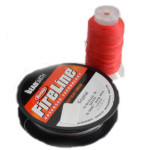 thread. I should begin by defining what I mean by the term ‘beading thread’: specifically this is the thread that is used for bead-weaving, so if you are looking for thread for stringing, then you will need to read this post. Bead-weaving includes techniques like Peyote stitch, RAW, Herringbone, Square Stitch, Netting and Bead Embroidery. At the end of the day, your choice of beading thread will be determined by a couple of factors: personal preference and what the pattern tells you to use! In a lot of cases many beading threads are interchangeable, but there are instances where a designer will have specified a particular thread for a very good reason. It is also fair to say that most people develop their own personal preference for beading thread, so if you are just starting out, try as many different threads as you can in order to find out which suits you best.
thread. I should begin by defining what I mean by the term ‘beading thread’: specifically this is the thread that is used for bead-weaving, so if you are looking for thread for stringing, then you will need to read this post. Bead-weaving includes techniques like Peyote stitch, RAW, Herringbone, Square Stitch, Netting and Bead Embroidery. At the end of the day, your choice of beading thread will be determined by a couple of factors: personal preference and what the pattern tells you to use! In a lot of cases many beading threads are interchangeable, but there are instances where a designer will have specified a particular thread for a very good reason. It is also fair to say that most people develop their own personal preference for beading thread, so if you are just starting out, try as many different threads as you can in order to find out which suits you best.
Nylon Based Beading Thread
Broadly speaking, beading threads currently fall into two categories: nylon based thread and Monofilament thread. It is easy to distinguish between the two. Nylon based thread feels a lot like sewing thread and it usually comes on a small spool or bobbin. When I started beading, Nymo was pretty much the only nylon beading thread that was readily available. It may come as no surprise to you to learn that now there are a lot more brands on the market. Take your pick from KO thread, C-lon, Miyuki beading thread……I could go on. There are subtle differences between the brands, but a lot of those differences are much easier to ‘feel’ through experience than describe. As each new manufacturer produces a new thread, they will claim that it is stronger, less likely to tangle and so on. I’m not saying this isn’t true, but I do find that one beader’s experience of a particular beading thread may not match another beader’s experience. A lot has to do with personal tension, or with the beads you are using for a project.
Having said that, there are some universal truths about nylon based beading thread that are helpful to know. Firstly, as I mentioned, it looks and feels a lot like sewing thread, or cotton. By this, I mean that it drapes in the same way, but is also tangles and knots if you aren’t careful…or even when you are careful! It is stronger than a sewing cotton, so don’t be tempted to just reach into your sewing basket for a reel of thread for your beading projects: the beading thread will be better!
Nylon beading thread can break more easily, especially if it is being used to stitch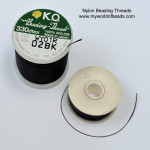 beads with rough edges, for example crystals or bugle beads. I have found that KO thread is a bit stronger than nymo, so is a better option, but I would always recommend using Fireline or another monofilament thread for working with crystals and bugles. Nylon thread is prone to tangling and knotting and, once it has knotted, it is very difficult to undo the knots. It is also easy to split a nylon based thread, so if you are making more than one pass through the same bead, you can easily find you have split the existing thread as you make the new pass. This isn’t catastrophic unless you have to undo your work, in which case, undoing through the split thread can be a challenge. Splitting thread can also be caused as a natural result of stitching, so if you are working with a long length of thread, it will pass through beads so many times that it can begin to split or fray near the end. If this happens, you should trim the thread to get rid of the split area. Any portion of thread that has split will be weaker and more likely to break, so it will make your beadwork weaker as well.
beads with rough edges, for example crystals or bugle beads. I have found that KO thread is a bit stronger than nymo, so is a better option, but I would always recommend using Fireline or another monofilament thread for working with crystals and bugles. Nylon thread is prone to tangling and knotting and, once it has knotted, it is very difficult to undo the knots. It is also easy to split a nylon based thread, so if you are making more than one pass through the same bead, you can easily find you have split the existing thread as you make the new pass. This isn’t catastrophic unless you have to undo your work, in which case, undoing through the split thread can be a challenge. Splitting thread can also be caused as a natural result of stitching, so if you are working with a long length of thread, it will pass through beads so many times that it can begin to split or fray near the end. If this happens, you should trim the thread to get rid of the split area. Any portion of thread that has split will be weaker and more likely to break, so it will make your beadwork weaker as well.
Nylon beading threads also have a natural stretch, so it is a good idea to cut your length of thread and then stretch it by holding one end in each hand and stretching your arms wide, then giving the thread a couple of good tugs. If you don’t stretch it before using it, the thread may stretch as you work and this can cause problems with beading tension for some people.
The good news is that nylon based thread can be conditioned with beeswax or a thread conditioner. This coats the thread and helps to stop it from tangling and splitting. You should condition the full length of your thread before you begin using it, then again as you are working if the thread starts to tangle too much.
There is other good news about nylon-based thread as well: it tends to be cheaper and it is available in a huge range of colours, so you can match your beading thread to the beads you are using in your project. If you are making a project with areas of beads in strongly contrasting colours, you can even change to a different colour of thread as you change bead colour. If you need some help on how to join or finish threads, then you can read this blog, for tips on threading your needle, try here, and you will also find some handy tips in the basic bead-weaving section of this site.
Monofilament Based Beading Thread
The most common brand of this beading thread is Fireline. It is available in different sizes, measured by weight: the most common are 4lb and 6lb. The weight refers to the weight that the thread will tolerate holding before it breaks. As you are most likely to be using this for bead-weaving and therefore each individual thread is only supporting a single bead or two, not for stringing where the weight of all the beads would be important, the 4lb weight is fine for most projects. Some people prefer 6lb – this is slightly thicker, so if you are going to be working with tiny seed beads, like size 15/0, then I would recommend sticking to the 4lb.
Fireline is basically only available in two colours: crystal and smoke. The smoke is a black coating applied to the crystal thread, so you will find as you use it that your fingers turn black, but enough coating remains on the thread to keep it dark. I do find though that the crystal is so close to ‘clear’ that it blends well with all bead colours, so I only use the smoke if I am working a project in all black or navy beads. Different people may advise differently there though!
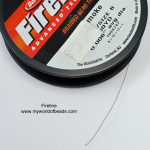 Monofilament based thread is basically just fishing line. I’m not certain of this, but I always like to imagine an enterprising beader ran out of thread mid-project and, desperate to finish, but unable to get to a beading shop, she was forced to raid her husband’s fishing supplies and discovered that the fishing line actually worked rather well! I’m sure that isn’t what really happened, but it is certainly the case that someone somewhere along the way had the bright idea of trying fishing line and this was then developed to the beading thread that we now use today. As you might imagine, this gives these types of thread a very different feel. They don’t drape in the same way as a nylon-based thread, so when you start using this type of thread, it can feel as though it has a little life of its own beside you as you pull it through the beads. If you can overcome the strangeness of that feeling, then this thread has so many benefits.
Monofilament based thread is basically just fishing line. I’m not certain of this, but I always like to imagine an enterprising beader ran out of thread mid-project and, desperate to finish, but unable to get to a beading shop, she was forced to raid her husband’s fishing supplies and discovered that the fishing line actually worked rather well! I’m sure that isn’t what really happened, but it is certainly the case that someone somewhere along the way had the bright idea of trying fishing line and this was then developed to the beading thread that we now use today. As you might imagine, this gives these types of thread a very different feel. They don’t drape in the same way as a nylon-based thread, so when you start using this type of thread, it can feel as though it has a little life of its own beside you as you pull it through the beads. If you can overcome the strangeness of that feeling, then this thread has so many benefits.
Unlike the nylon-based thread, it doesn’t have a natural stretch, so I find that this really helps to create a good tension: once you have pulled the thread through, it stays where you pulled it and doesn’t start to spring back. This is especially advantageous with Right Angle Weave or Netting I think. I also find it very difficult to break my Fireline, so apart from the occasional rogue thread, I have very rarely found my thread snapping midway through stitching. Finally, the monofilament thread is much less prone to knotting: it will still tangle and it will wrap itself into little loops and knots as you work, but these are usually very easy to undo and they seem not to weaken the thread, so in my experience, this makes for a much less frustrating beading session!
Different beaders will advise different ways of finishing off Fireline: some say that because it doesn’t knot so well, it is better to weave your thread through your beads before ending off. Others, like me, happily knot between beads with this. I have heard warnings that knotting the thread to start or finish it can cause it to break, but I have never experienced this problem firsthand.
Monofilament beading threads are considerably more expensive than the nylon-based, so this alone puts some people off using them. However, if you are sold on all the other advantages and you want a beading project that will stand the test of time, then you may feel the extra investment is worthwhile.
As I said at the beginning, every beader falls in love with a different brand of thread, so if you are starting out, try lots of brands – beg a length off a friend at a beading group or in a workshop if you want to try before you buy – and get to know what feels good for you. If you really hate a particular brand, but the designer recommends using it for their pattern, I would suggest the designer might have good reason for their recommendation, but on the other hand, don’t be afraid to use a different thread – just bear in mind that you might experience some unexpected difficulties as you go! Hopefully at least you will now have a better idea about what you are buying when you are faced with all those different brands. If in doubt, ask the shop owner to tell you a bit more about the brand and at least these hints will hopefully help you to understand the information you are being given.


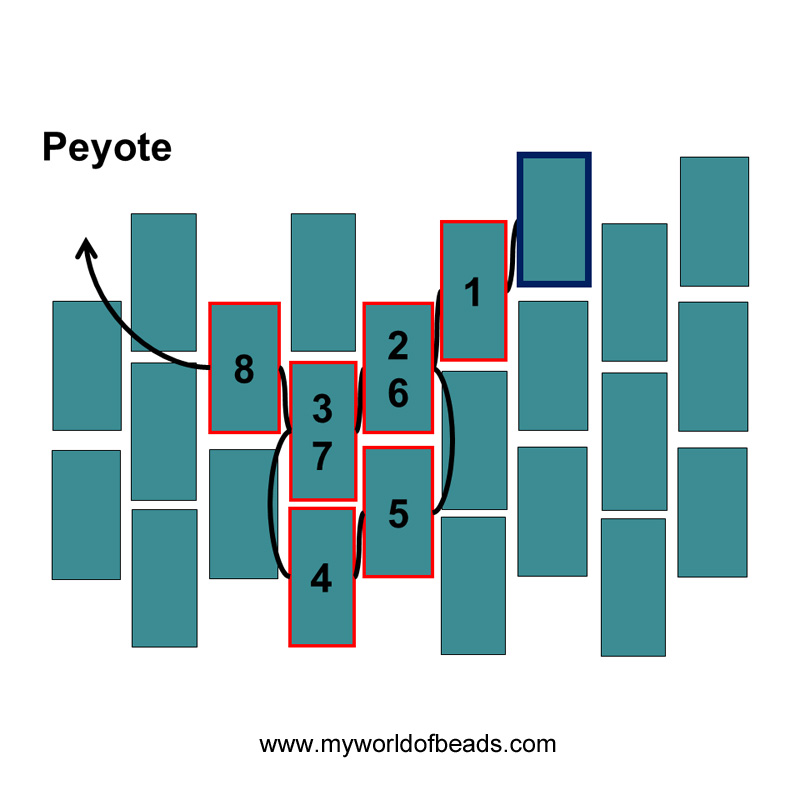
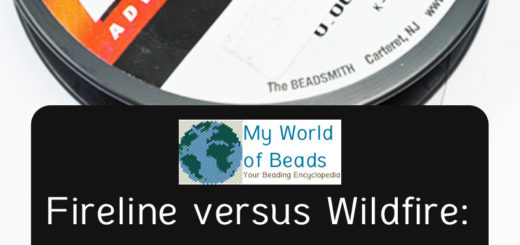
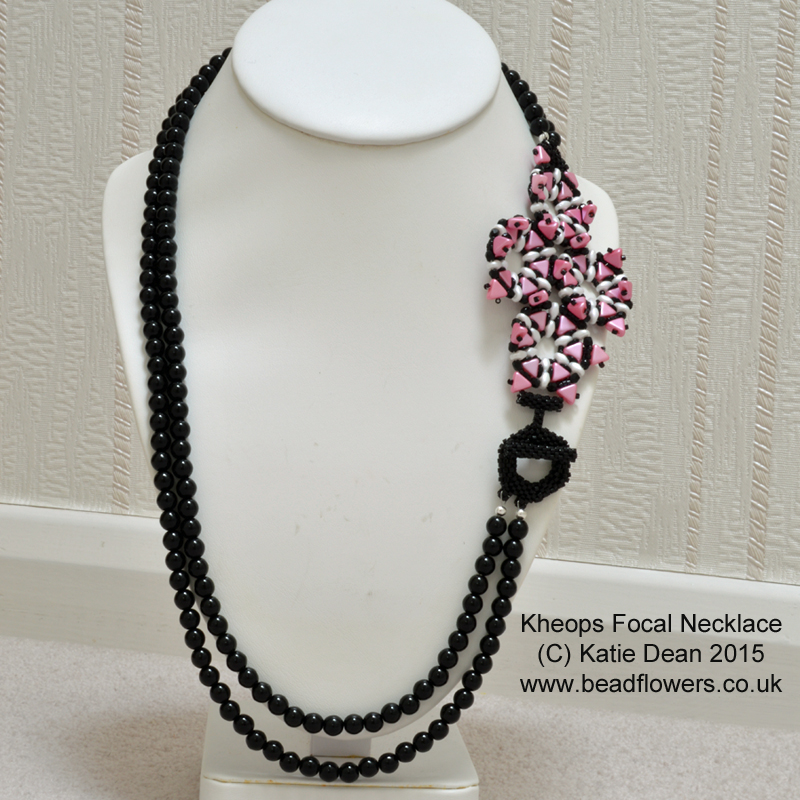






On the contrary, I find fireline breaking way too easy when using crystals.I work mostly with Swarovski pearls and crystals, and 9 out of 10 bracelets end up breaking shortly after.Same thing with wildfire,8 lb test included. Now I am in the process of fixing some using dandyline.Will see how that goes.
That’s interesting Anneliz. After writing that post, I was chatting with another beading friend and she also has problems with Fireline breaking. I use the Beadsmith brand and I think there is some difference between brands too. But I am also finding that different people just get on with different threads. So, that’s why, when you start out, it’s such a great idea to try lots of different types of thread and see what works for you. So, I hope the dandyline does the job for your projects!
Thanks for reading and commenting,
Katie
I made 18 necklaces and bracelets of Swarovski pearls to give away, they all broke almost within an hour or less. I had used Fireline 6 lbs and I had threaded twice to make them stronger. I was devastated and feel that this is a scam business with beads. What can I do, I owe my daughter and grand daughters some new ones because they loved them until they broke. It broke my heart to see the pearls dancing all over the ground. Must be a dry rot? Can I be reimbursed for the Fireline or can you recommend something better.
I’m so sorry to read this Ingegerd. I absolutely sympathise with your devastation at seeing all your hard work break. I’ve never experienced that problem with 6lb Fireline myself, but I know it can happen. You would have to contact the shop where you bought the Fireline to talk to them about getting your money back. I’m struggling to think of something better. If these are pearls, it might be worth trying a proper pearl stringing silk – again, ask at your local store for their recommendation. It could also be a good idea to learn how to string pearls professionally. This involves knotting between each pearl so that if the worst does happen, you don’t lose everything. I actually have a free tutorial to show how to do that, which you can find at this link:http://beadflowers.co.uk/beads/free-tutorials/knotting-pearls-free-pattern/ But, definitely don’t try this with Fireline – that type of thread isn’t designed for knotting! I hope that helps a little. Don’t lose heart – beading isn’t a ‘scam’ business, but it is easy to make mistakes when you start if you don’t know so much about the techniques and materials. So, hopefully the shop where you bought the supplies will be happy to help you.
Thanks for your suggestions!
Thank you for writing about your experience with the different types of thread. I am fairly new to beading, but have done some research and I think there is an error in terminology in your writing here. You are mixing the categories of ‘materials’ (nylon) with the categories of ‘type of fibre’ (monofilament, ie. single-strand, man-made fibre).
So, K.O and Nymo are both Nylon products. Nymo is a monofilament nylon thread. I am not sure if K.O. on the other hand is a multi-strand nylon.
As for Fireline: Fireline is NOT a monofilament. Fireline is made from Polyethylene, which is spun and then theramally fused. Other polyethylene-based multi-strand fishing lines are braided (e.g. Power Pro). There are monofilament fishing lines, but I haven’t heard of people using them for beading. They are usually a lot cheaper then the high-tech products as Fireline and PowerPro [and there are others in this category]) and I believe less durable.
(my reference is the Bead Thread Info Chart at fusionbeads: http://www.fusionbeads.com/beading-thread-q-and-a)
Further, according to Beadsmith. Fireline bought from them is exactly the same as bought in a fishing store. Three reasons for buying Beadsmith branded Fireline:
a) comes in smaller quantities (for a higher price);
b) it comes in an additional color not found in fishing stores: Satin black doesn’t give up as much color as does smoke when you run it through your hands;
c) I have found it impossible to find the 4lb quality in a fishing stores. And this variety does come in handy when you need to pass through 15/0 more than twice.
Thank you very much for this additional information and for your corrections – I appreciate your time and help with this.
Katie
For the last 10 years in doing boxes, I have followed a kind suggestion by Julia Pretl to use Silamide. It is a polyester thread and has the most amazing capability to make RIGID tension. So my box sides as as firm as wood. And it holds up stiff without loosening over time (this was my experience with fireline). It is A thickness so I sew with doubled thread. I do not have breakage and I really pull on the thread. Comes in lots of colors also. Only difficulty is threading a needle as it is 2 ply twisted and you really need a needle threaded. Easy enough done.
Thanks Clare – that’s great to know. I’ll have to give it a try. Thread is always such a personal thing, I find. Everyone has their favourites, but I like to try new threads to see how I like them…after all, my current favourite is only the ‘best’ out of what I’ve tried! Thanks for sharing that tip with everyone.
Katie
Do you have to pre-stretch Silamide, as you do Nymo and KO?
I’ve used Silamide for years and it’s my go-to thread. I have Fireline which I use with crystals or other sharp beads, but I’ve been very happy with Silamide. It drapes well for fringes, with proper tension it created a stiff fabric with most stitches. It holds up well even when I’m using a very long length; some tangles and knots but no more than any other nylon thread and easy enough to prevent while beading. I haven’t had any issues with finished pieces breaking; in the past I’ve had issues with Nymo on pieces that are a few years old. I haven’t seen any noticeable stretching, and I’ve done a lot of decorative pieces with heavy fringe.
Thank you Cinde! That’s great to hear and I’m sure will be helpful for others reading this too. I appreciate you sharing your experience.
Does anyone know if Fireline can handle a dip in a silver anti tarnish liquid. I have a beautiful piece I made with silver and gold plated delicas and it is completely tarnished.
I don’t have an answer to that…if anyone else reading this can help, then please add your comments!…but I would suggest trying to just dip some Fireline in the liquid and see what happens to it. My thought would be that if that survives, then it should be fine within the beading. It’s also best to test on a few odd beads as well…just in case they behave differently to other silver or gold plated objects! Good luck – I hope you manage to restore your beautiful work.
Help! I made a lovely beaded curtain for my granddaughter’s closet using 60 lb braided fishing line. I have now replaced nearly half of the individual strands because the thread keeps breaking! At first I thought it was the crackle beads fraying the line. But now I’m replacing the same lines after removing the crack beads. What’s the best thread to use?
Should the thread be passed through twice when beading on a loom using seed beads?
I don’t really understand your question, Judy…what do you mean by ‘passed through twice’? The thread naturally passes through the beads twice – first when you pick them up, second when you pass back through them to secure them to your work. Are you asking about additional passes beyond that basic necessity?
Could you please advise me on what size of thread guardians I need to use for my miyuki delica/seed bead 11/0 ear rings – I’d like to use those to connect the bead work with the ear hooks. But I don’t know what size and which kind of metall would be best. I’d like to have them in just gold and silver colour and they should be of good, long lasting quality – besides not too expensive. Your kind advise on size, metal and maybe also where to order it online, would be highly appreciated.
Greetings from – the presently very troubled paradise of – Sri Lanka.
Ingrid
Thank you for your question, Ingrid. I’m afraid I don’t have a specific recommendation for you – I’m not an expert with thread guardians. In general, though, I would always go for sterling silver, or Vermeil (for gold..it’s gold layered on sterling silver) as this is the best quality metal for lasting. In terms of size, it’s really best to try – the best size may depend on your design, in my opinion.
But I am also going to invite others reading this to leave their thoughts if they have suggestions for you.
Sending love and blessings to all in Sri Lanka, Katie